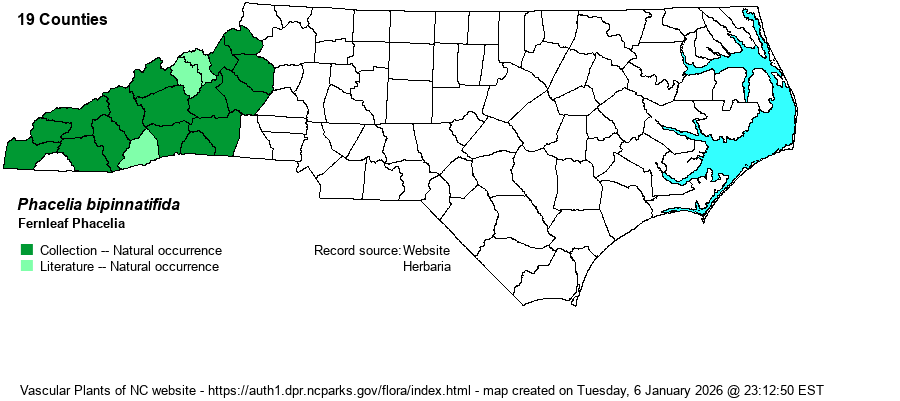| Distribution | Essentially throughout the Mountains, and also ranges barely into the western edge of the Piedmont. However, no records as yet from VA border counties -- Ashe and Alleghany, nor from neighboring Wilkes County.
This is an Ohio/Tennessee Valley species, ranging mostly west of the state. It ranges from WV and OH west to MO, and south to northern GA and AL. | |
| Identification | This is a fairly slender species, containing a few branches and reaching about 1-1.5 feet tall. There are scattered alternate leaves along the stem, each with long petioles of 1-2 inches in length, and a blade about 3 inches long. The blade is deeply cut, often to the midrib, into about 5 segments, with additional smaller teeth along the leaf margins. The inflorescence is typically solitary, at the end of the stem, but there are multiple "branches" within this cluster of helicoid cymes, such that there can be 15-20 or more moderate-sized purple to lilac to blue-purple flowers visible at a single time. Each flower is about 1/2-inch across, with 5 rounded petals, in an open bell shape; in this species, the petals are entire and not fringed. The species might be somewhat difficult to identify by most biologists when not in bloom, and a few other plants have strongly jagged leaves like this species. But, once the soft purple flowers are present, it cannot be confused, as other Phacelia species have white or pale pink flowers, several species with fringed petals. Actually, Hydrophyllum virginianum is the most similar species, as that species has strongly dissected leaves and often purple flowers. But, its flowers are in dense, compact "heads", the flowers are more bell-shaped and not as flat in profile as is Phacelia, plus Hydrophyllum flowers have stamens that protrude far beyond the petals. You should be able to find this species on some of the spring wildflower walks in mountain coves in late April or early May, and relatively few such species have soft purple to blue-purple flowers. | |

